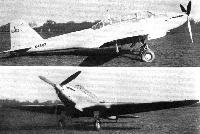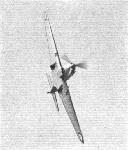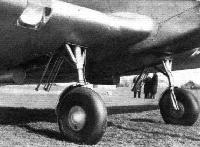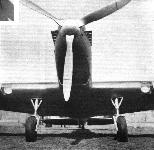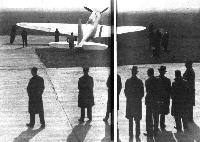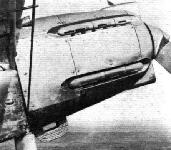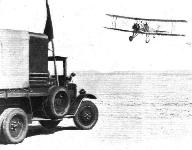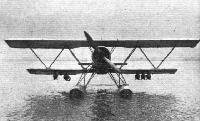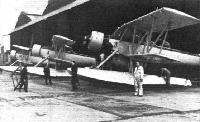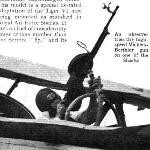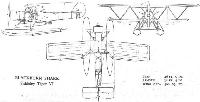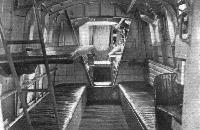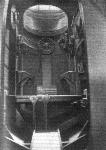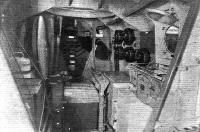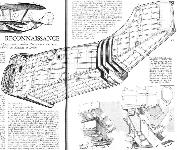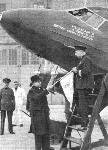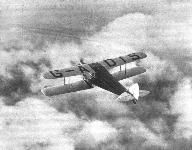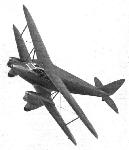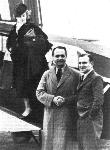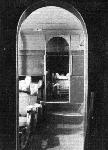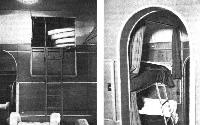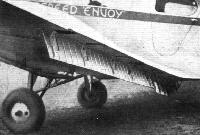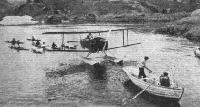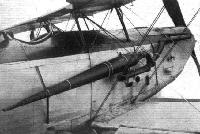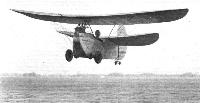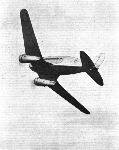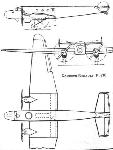Фотографии
-
Регистрационный номер: K4586 A NEW "HEAVY." The Armstrong-Whitworth Whitley (two Tiger engines).
Самолёты на фотографии: Armstrong Whitworth Whitley / A.W.38 - Великобритания - 1936
-
Регистрационный номер: K4303 [5] A LA MODE: The veil of official secrecy has been partially lifted from the shapely Fairey bomber monoplane, known as the Battle. Its engine is one of the new Rolls-Royce "Merlins"; its covering of metal; its undercarriage semi-retractable; and its performance, if known, a State secret.
Самолёты на фотографии: Fairey Battle - Великобритания - 1936
-
Регистрационный номер: K4303 [5] Самолёты на фотографии: Fairey Battle - Великобритания - 1936
-
The undercarriage of the Fairey Battle retracts upwards and backwards into recesses in the wings. A fairing helps to streamline the uncovered portion of the wheel.
Самолёты на фотографии: Fairey Battle - Великобритания - 1936
-
Регистрационный номер: K4303 [5] Single-strut cantilever wheel suspension is a feature of the Fairey Battle. Note the orientable landing lights in the leading edge. The Fairey three-bladed airscrew is of small diameter so that a low undercarriage can be used.
Самолёты на фотографии: Fairey Battle - Великобритания - 1936
-
Регистрационный номер: K4303 [5] Some idea of the beautiful plan form of the Fairey Battle may be gathered from this three-quarter rear view.
Самолёты на фотографии: Fairey Battle - Великобритания - 1936
-
Регистрационный номер: K4303 [5] All control surfaces of the Battle are fabric covered. The rest of the machine has a metal skin. The trimming tabs can be seen on the left, while the other shows a student of design doing poojah to the trailing-edge flaps.
Самолёты на фотографии: Fairey Battle - Великобритания - 1936
-
The small frontal area of the twelve-cylinder Rolls-Royce Merlin engine is well brought out in this end-on view.
Самолёты на фотографии: Fairey Battle - Великобритания - 1936
-
Регистрационный номер: K8626 A MAJOR IN UNIFORM: A Miles Hawk Major (130 h.p. Gipsy Major) has been delivered to the Service and is the first of its type to bear the familiar targets.
Самолёты на фотографии: Miles Hawk / M.2 - Великобритания - 1932
-
Регистрационный номер: D-AGIR Dornier Do 23G. The curious form of the wings is apparent in this view of the Dornier bomber-transport, and the auxiliary aileron-cum-flap surfaces are visible.
Самолёты на фотографии: Dornier Do.13 / Do.23 - Германия - 1934
-
PAN AMERICAN DEBUTANTE. American modernity is the keynote of this view of the first Fairchild Baby Clipper (P. & W. Hornet) moored after its delivery flight to Pan American Airways at the International Airport, Miami. This particular machine will be used between Para and Manaos down the Amazon River.
Самолёты на фотографии: Fairchild Model 91 Baby Clipper - США - 1935
-
Points of interest to be seen in this elevation of the Fairchild Baby Clipper include the anchors and drogues in the bow compartment, airscrew guard over the forward hatch, accommodation for passengers and crew, retracting tail wheel and the general compactness of the whole layout. The engine is a 750 h.p. nine-cylinder Hornet radial.
Самолёты на фотографии: Fairchild Model 91 Baby Clipper - США - 1935
-
Attention to an engine. The ladders are very light and handy, and are carried on board.
The "kidney" or "ramshorn" type of exhaust system, which gives a noise reduction equal to that obtained with the more usual perforated tail pipes, is standard equipment on certain R.A.F. machines, notably the Handley Page Heyford.Самолёты на фотографии: Handley Page Heyford / H.P.38 / H.P.50 - Великобритания - 1930
-
Farnborough and Napier engineers collaborated in the design of the exhaust system for the Napier Dagger III engine in the Hawker Hector. The four exhaust units are sunk into troughs, thereby decreasing resistance.
Самолёты на фотографии: Hawker Hector - Великобритания - 1936
-
INFRA-DIG: Natives wait behind the hills for hours while R.A.F. machines in Egypt do their gunnery practice. As soon as the shooting has stopped they dash to the targets, grub for bullets in the sand and sell them at two-pence farthing per hundred to dealers. Here is a Vickers Vincent at practice.
Самолёты на фотографии: Vickers Vincent / Type 266 - Великобритания - 1932
-
One of the Portuguese Sharks with full bomb load.
Самолёты на фотографии: Blackburn Shark / B-6 - Великобритания - 1933
-
Самолёты на фотографии: Blackburn Shark / B-6 - Великобритания - 1933
-
In the foreground may be seen one with the external auxiliary tank under the fuselage.
Самолёты на фотографии: Blackburn Shark / B-6 - Великобритания - 1933
-
An observer tries the highspeed Vickers-Berthier gun on one of the Sharks
Самолёты на фотографии: Blackburn Shark / B-6 - Великобритания - 1933
-
Blackburn Shark Siddeley Tiger VI
Самолёты на фотографии: Blackburn Shark / B-6 - Великобритания - 1933
-
Comfort for the crew of the Saro London. This compartment lies between the kitchen and the officers' wardroom. The wireless operator's chair can be seen on the right of the picture.
Самолёты на фотографии: Saunders-Roe London / A.27 - Великобритания - 1934
-
The rear gunner commands a wide field of fire, including vertically downwards. His cockpit is in the extreme stern and between the spars of the tailplane.
Самолёты на фотографии: Saunders-Roe London / A.27 - Великобритания - 1934
-
The front gunner's compartment also contains the bomb sight and bomb releases, ammunition and marine gear.
Самолёты на фотографии: Saunders-Roe London / A.27 - Великобритания - 1934
-
The middle gunner's compartment, which is also the kitchen and pantry. The firing step serves as a work bench. Note the vice.
Самолёты на фотографии: Saunders-Roe London / A.27 - Великобритания - 1934
-
Самолёты на фотографии: Saunders-Roe London / A.27 - Великобритания - 1934
-
The tailplane of the Saro London has spar booms of the Boulton Paul "locked joint" tubular type. The cut-out near the rear spar is for the stern gunner.
Самолёты на фотографии: Saunders-Roe London / A.27 - Великобритания - 1934
-
The hull of the Saro London. Straight-line frames are used, those in the rear portion, and the sides of those in the front part, being of "Z" section, and the rest of channel section. The planking is corrugated or fluted to avoid the use of riveted-on stringers. Note the neat pressed caps used to cover the ends of the corrugations. Details of the construction of the rear step are shown below.
Самолёты на фотографии: Saunders-Roe London / A.27 - Великобритания - 1934
-
TEST BED: This catapult is intended for installation on the French cruiser Lorraine and here is seen installed on a jetty at Saint Nazaire for preliminary tests. The machine is a Loire 130 reconnaissance flying boat with 690 h.p. Hispano X engine.
Самолёты на фотографии: Loire Loire 130 - Франция - 1934
-
Регистрационный номер: CF-ARI SALVAGE: This Junkers W.34, owned by Canadian Airways, fell through the ice while taxying near Port Chipewyan and was saved from complete immersion only by the low wing structure. Twelve days were taken in the work of salvage, but comparatively little damage was done.
Самолёты на фотографии: Junkers W 33 / W 34 / Ju.46 - Германия - 1926
-
The Bristol company has developed a very efficient single-outlet exhaust collector ring for its latest engines. Here it is embodied in the N.A.C.A. cowling of a Pegasus-Douglas
Самолёты на фотографии: Douglas DC-1 / DC-2 / C-32 / C-39 - США - 1933
-
Captain Anderson, chief pilot of British Airways, receives the air mail pennant.
Самолёты на фотографии: De Havilland Express Air Liner / D.H.86 - Великобритания - 1934
-
Регистрационный номер: G-ADIS This somewhat unusual flying picture of the Hornet Moth gives a good idea of the upward and rearward view given by the roof windows and also clearly shows the new wing form.
Самолёты на фотографии: De Havilland Hornet Moth / D.H.87 - Великобритания - 1934
-
The comfortable accommodation, wide field of view and ample luggage space are brought out in this impression of the interior of the new Hornet Moth.
Самолёты на фотографии: De Havilland Hornet Moth / D.H.87 - Великобритания - 1934
-
Самолёты на фотографии: De Havilland Dragonfly / D.H.90 - Великобритания - 1935
-
A diagrammatic view of the Dragonfly's cabin layout, which is extraordinarily spacious. Any of the passengers and/or pilots can change seats in the air without the slightest difficulty. In addition to the main windows, small windows at the rear give the back-seat passengers a view downwards without neck-craning.
Самолёты на фотографии: De Havilland Dragonfly / D.H.90 - Великобритания - 1935
-
Регистрационный номер: YR-NIC YR-NIC are the appropriate registration letters of an S.T.25 Monospar specially built for the personal use of Prince Nicholas of Roumania. The Prince's pilot, Capt. Nicolai Opris (centre) is see bidding farewell to Mr. L. R. E. H. Castlemaine, of General Aircraft, Ltd., before flying the machine home; the lady is Capt. Opris' wife.
Самолёты на фотографии: General Aircraft Monospar ST-25 Universal - Великобритания - 1935
-
Регистрационный номер: VH-AJM A PHOENIX FOR AUSTRALIA: Mr. C. J. Melrose with the Heston Phoenix which he is shortly flying out to Australia in easy stages. This machine is the first of the production batch and incorporates certain improvements, mainly an even better view than before from the pilot's seat and a somewhat neater Dowty retractable undercarriage. Mr. Melrose hopes to carry a few expense-sharing passengers.
Самолёты на фотографии: Heston Phoenix - Великобритания - 1935
-
A portion of the middle cabin, with steps leading up to the after cabin, which is on a slightly higher level. On the port side there are no chairs, the floor space being used as a small promenade deck. A hand rail runs along under the windows.
Самолёты на фотографии: Short Empire / S.23 - Великобритания - 1936
-
During the daytime the berths and bedding are stored in the "loft" above one of the main cabins. How the berths are arranged in the small cabins between the spar frames is shown on the right.
Самолёты на фотографии: Short Empire / S.23 - Великобритания - 1936
-
An impression of the Empire boat alighting at night. A retractable landing light is on the port bow.
Самолёты на фотографии: Short Empire / S.23 - Великобритания - 1936
-
The internal accomodation of the Short Empire boat. This sketch was obtained from the very elaborate "mock-up" built before setting details.
Самолёты на фотографии: Short Empire / S.23 - Великобритания - 1936
-
Регистрационный номер: G-AAXD A NEW COAT for Horatius in Imperial Airways' workshops being quickly administered by the B.E.N. Patents P.10-type portable spraying plant seen in the foreground. Driven either by an electric motor or small petrol engine this plant is particularly suitable for dope spraying, and is one of the several different types made by B.E.N. Patents Ltd., Gorst Road, Park Royal, London, N.W.10 - who, incidentally, have recently received a Government contract for similar equipment.
Самолёты на фотографии: Handley Page H.P.42 / H.P.45 - Великобритания - 1930
-
F/O. Llewellyn with the 40 h.p. Aeronca which carried him on a demonstration trip to Johannesburg.
Самолёты на фотографии: Aeronca C - США - 1929
-
The new Envoy is shown in cruising trim.
Самолёты на фотографии: Airspeed Envoy / AS.6 - Великобритания - 1934
-
Safe and slow: Flt. Lt. Colman makes a demonstration landing just over the Heston boundary marks.
Самолёты на фотографии: Airspeed Envoy / AS.6 - Великобритания - 1934
-
In three sections extending right across the centre section, the Airspeed split flaps are hydraulically operated.
Самолёты на фотографии: Airspeed Envoy / AS.6 - Великобритания - 1934
-
Регистрационный номер: G-EBVG BORN 1928 ... : Given a new lease of life with three Siddeley "Tiger VI" engines this eight-year-old Calcutta will be used for flying-boat training by Imperial pilots at Hamble.
Самолёты на фотографии: Short Calcutta / Rangoon / S.8 - Великобритания - 1928
-
Mr. Grrerson's Fox Moth leaving Angmagssalik, followed by a fleet of Eskimo kayaks. This snapshot was taken by Capt. Mikkelsen from the supply ship which visits the settlement once a year.
Самолёты на фотографии: De Havilland Fox Moth / D.H.83 - Великобритания - 1932
-
JOHN GRIERSON at Ottawa during his flight; with him is Wing Cdr. Godfrey, C/O of the Royal Canadian Air Force at Ottawa.
Самолёты на фотографии: De Havilland Fox Moth / D.H.83 - Великобритания - 1932
-
NOT A STRANGE STREET PROCESSION, as a first glance suggests, but a Royal Marines band playing during inspection on the aircraft carrier Furious. The machines are Fairey III Fs.
Самолёты на фотографии: Fairey Fairey IIIF - Великобритания - 1926
-
This is a Vokes silencer on a Kestrel-engined Fairey IIIF which was used for silencing research. The by-passing arrangement to the normal exhaust pipe is visible.
Самолёты на фотографии: Fairey Fairey IIIF - Великобритания - 1926
-
Регистрационный номер: G-ADMH [2] THIS ONE FLIES! Remembering the general tendency to be humorous at the expense of the Pou, here is photographic evidence of the fact that the Carden-engined model flies - and flies well. Mr. S. V. Appleby, of course, is the pilot. A reasonable supply of power with careful construction and rigging help to explain its successful performance; one of the rigid incidence control rods can be clearly seen.
Самолёты на фотографии: Mignet Pou-de-Ciel / HM-14 - Франция - 1932
-
LOST: ONE BEDSTEAD? Mr. Tom Proctor, builder of Blackburn's first Pou, being convoyed to the local Pen-proving ground. The engine is by British Anzani and the undercarriage, apparently, by Mr. Drage; but it may be lighter than it looks.
Самолёты на фотографии: Mignet Pou-de-Ciel / HM-14 - Франция - 1932
-
Регистрационный номер: G-ADMH [2] Two views of a model Pou-de-Ciel built by an American enthusiast, Mr. K. W. Hamilton.
Самолёты на фотографии: Mignet Pou-de-Ciel / HM-14 - Франция - 1932
-
Регистрационный номер: G-AECB Flt. Lt. Schofield has been carrying out extensive flight tests during the last few weeks of General Aircraft's new ten-passenger monoplane. Of all-metal construction, it is fitted with two Pratt and Whitney Wasp Juniors. The photograph brings out the pronounced sweep-back given to the wings; the very low setting of the tailplane on the fuselage is another unusual feature. For this, the first aerial photograph of the S.T.18 to be published, the machine was piloted by Flt. Lt. Schofield, and Mr. Seth Smith handled the S.T.10 which carried Flight's photographer. The medium-supercharged engines ensure good performance at high altitudes and yet in conjunction with the Hamilton C.P. airscrews an excellent take-off. The rearward retracting undercarriage is not the least interesting feature.
Самолёты на фотографии: General Aircraft Monospar ST-18 Croydon - Великобритания - 1935
-
An artist's conception of the little Pobjoy-engined C.L.W. trainer now "on the stocks." It has been designed primarily for special training in these days of high-performance low-wing military types.
Самолёты на фотографии: CLW Curlew - Великобритания - 1936
-
The attractive layout of the forthcoming C.L.W. trainer is apparent from these general arrangement drawings.
Самолёты на фотографии: CLW Curlew - Великобритания - 1936
-
IN MINIATURE: An imposing view of the Stinson Model A (three 260 h.p. Lycomings) which has been designed specifically for feeder line operation in America. The rights for this machine, which, in its "export" form, has a fixed undercarriage, have been acquired by Brian Allen Aviation, of Croydon. It is possible that we shall see three Stinsons in operation here in the near future.
Самолёты на фотографии: Stinson Model A - США - 1934
-
Caudron-Renault R.570
Самолёты на фотографии: Caudron C.570 Kangourou - Франция - 1935
-
The projected C.L.W. twin-engined transport, with two Siddeley Cheetahs.
Самолёты на фотографии: CLW twin-engined transport - Великобритания - 1936
Статьи
- Flight
- Flight Advertisements

